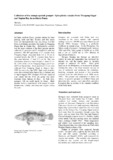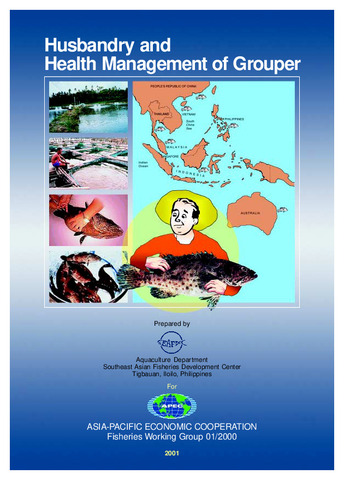Assessment of grouper resources around Zamboanga City and Basilan, Philippines
- Global styles
- MLA
- Vancouver
- Elsevier - Harvard
- APA
- Help
Share
นามธรรม
A total of 2,643 kg of groupers were collected from six markets (96% of the biomass) and from prescribed fish traps in three fishing grounds (106 kg, 4%) around Zamboanga City and Basilan from November 1993 to October 1994. The collection included 26 species in seven genera: Aethaloperca, Cephalopholis, Cromileptis, Epinephelus, Niphon, Plectropomus, and Variola. The three species of highest biomass were Epinephelus fasciatus (26%), Cephalopholis sonnerati (14%) and Cromileptis altivelis (13%). The least biomass was contributed by Epinephelus sexfasciatus (0.1%), Plectropomus areolatus (0.1%), and Cephalopholis sexmaculatus (0.3%). Grouper biomass was lower from November to April and greater from May to October. Groupers caught by the prescribed fish traps were mostly Epinephelus merra (50% of the total). The highest catch of grouper was 0.8 kg/fish trap around Sta. Cruz Island in July, and the highest catch of all demersal fishes was 7 kg/trap around Malamawi Island in September. On average, groupers made up less than 10% of the monthly catch of fish traps. The groupers collected from the markets and from the fish traps averaged 28 cm in total length— all young juveniles. Cromileptes altivelis (average 38 cm) were the largest individuals and Plectropomus spp. (36 cm) similarly so. The largest C. altivelis (1.5 kg) was caught in December and the smallest (0.8 kg) in April and August. The various Cephalopholis species averaged 31 cm, and the various Epinephelus species were smallest at 26 cm. Groupers were largest in December and smallest between January and May. Length-weight equations were derived for seven grouper species. Of the 78 grouper stomachs that were dissected, 52 were empty and 26 contained food, mainly crabs, anchovies, hermit crabs, soldierfish, squids, and shrimps. Groupers with mature and ripe varies had from 3,000 to 11,000 eggs per gram ovary.
การอ้างอิง
Lasola, N. T., Samson, R. A., & Domingo, P. B. (2007). Assessment of grouper resources around Zamboanga City and Basilan, Philippines. In T. U. Bagarinao (Ed.), Research Output of the Fisheries Sector Program (Vol. 2. Reports on Fisheries and Aquaculture, pp. 105-108). Quezon City, Philippines: Bureau of Agricultural Research, Department of Agriculture.
Type
Book chapterISBN
9718511776
Related items
Showing items related by title, author, creator and subject.
-
Philippine National Standard: Live, chilled/frozen grouper
Bureau of Agriculture and Fisheries Standards (Bureau of Agriculture and Fisheries Standards, 2009)This Philippine National Standard for live, chilled/frozen grouper identifies the Philippine species of grouper, specifies their essential composition and quality factors (including size classification and quality ... -
Collection of the orange-spotted grouper Epinephelus coioides from Tinagong Dagat and Sapian Bay in northern Panay
Solis, Noel B. (Bureau of Agricultural Research, Department of Agriculture, 2007)In Capiz, northern Panay, grouper catches by hand picking, hook and line, shelters, and fish corral were low throughout the year, on average 1-3 fish from each fishing operation, but higher in Tinagong Dagat than in Sapian ... -
Husbandry and health management of grouper
Asia-Pacific Economic Cooperation; Southeast Asian Fisheries Development Center (Asia-Pacific Economic Cooperation; Aquaculture Department, Southeast Asian Fisheries Development Center, 2001)The groupers (Family Serranidae) are among the most popular species in the live reef food fish industry in the Asia-Pacific region. Groupers are generally fast growing, hardy, suitable for intensive culture, and with ...





